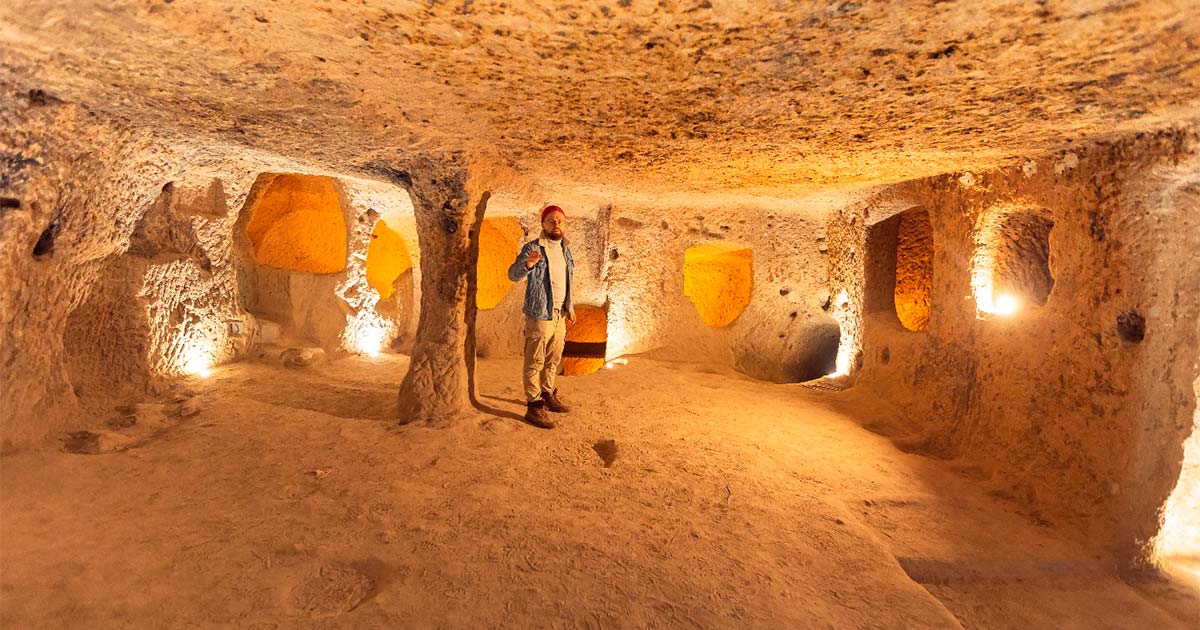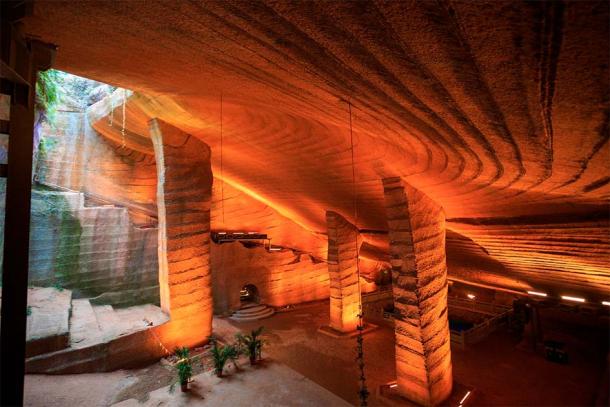
This iten addresses the extensive global nature of large underground complexes built in competant living rock . Typically dry even though that may well be what we can see.
From the evidence, it is based upon a lifeway that conforms to the global Bronze Age and post stone Age. No obvious flints and all that. We are also missing the above ground surround in most of this or at least seeing only bits and pieces.
so why were they built? Certainly they can provide protection and storage until an attacking force went away.. That may be good enough.
what is not understood is how? They used a blow torch type device with a collar to popcorn the underying stone. The third picture here shows us just that. That can easily be trimmed with mallets as necessary.
Once a crew was at work with a air pusher and tubes along with any flammable oil, you are in business.
Discoveries of Ancient Underground Cities Around the World
UPDATED 13 MAY, 2023 - 23:01 JOANNA GILLAN
https://www.ancient-origins.net/ancient-places/underground-cities-00559?
Beneath the surface of our world, hidden under layers of soil, stone, and history, lie remnants of ancient civilizations - vast networks of tunnels, expansive underground cities , and complex subterranean structures. Our ancestors demonstrated remarkable ingenuity, carving out these intricate labyrinths for reasons as diverse as their cultures. Whether born out of necessity, spirituality, or security, these underground marvels have been preserved, waiting to share the untold stories of our human past.
This Day in History: Pope John Paul II Is Shot (Saturday, May 13)00:00/01:01
South and Central America
In the heart of Mexico, the ancient city of Teotihuacan houses an extensive labyrinth of tunnels beneath the Pyramid of the Sun. Discovered only in the 1970s, this intricate network of tunnels extends to over 5 kilometers, with rooms branching off in various directions. These chambers are believed to have been used for rituals and ceremonies, with artifacts such as sculptures, pottery, and even human remains unearthed during excavations. The tunnels of Teotihuacan offer a unique insight into the spiritual and cultural life of this ancient civilization.
In 2008, another remarkable discovery was made in Mexico that further underscored the importance of the underground in Mesoamerican cosmology and architecture. Archaeologists uncovered eleven stone temples inside an underground cave system beneath the Yucatan Peninsula, complete with an underground road which the Mayans believed led to the mythical underworld city known as Xibalba. The underworld was a crucial part of the Mayan spiritual belief system, with Xibalba often depicted as a dangerous place filled with deadly trials for deceased souls.
In Peru, the Qenqo Chico tunnel network is an impressive example of Incan engineering. These tunnels, part of the larger Qenqo archaeological complex near Cusco, were carved directly into the rock and are thought to have been used for religious and ceremonial purposes. Qenqo Chico and its subterranean passages continue to fascinate archaeologists and tourists alike, offering a glimpse into the spiritual life of the Inca civilization.
The sprawling Mayan pyramid complex at Tikal , located in present-day Guatemala, has also revealed an intricate system of underground tunnels. These tunnels, rediscovered in the late 20th century, appear to connect various parts of the vast city-state, suggesting an efficient transportation or communication system. However, their exact function remains the subject of ongoing study. What is clear, however, is that these subterranean structures provide significant insights into the city planning and architectural capabilities of the ancient Mayan civilization, which flourished at Tikal from around 200 to 900 AD

Underground shrine at Qenqo Chico, Peru. Source: Leon petrosyan / CC by SA 3.0
Africa
In Ethiopia, the rock-hewn churches of Lalibela represent an impressive feat of subterranean architecture. Carved directly into solid rock in the 12th century, these 11 monolithic churches were reportedly created to represent a symbolic representation of Jerusalem. Each church was chiseled out of the ground, then further shaped into doors, windows, columns, and decorated with carvings. This UNESCO World Heritage site is a testament to the ingenuity of ancient African architects, and the underground network connecting the churches adds to the mystical aura of Lalibela.
In Egypt, the Giza Plateau has an enormous underground system that is a combination of manmade caverns and tunnels as well as subterranean rivers and passages. Since 1978 the caverns have been mapped using ground penetrating radar with explorations led by Dr Jim Hurtak who has allegedly entered massive chambers larger than our largest cathedrals. A few historians believe that the underground cave system in Giza, is the legendary ‘City of the Gods’, a massive underground city described by ancient writers Herodotus (5 th century BC) and Strabo (1 st Century AD). Herodotus wrote:
“There I saw twelve palaces regularly disposed, which had communication with each other, interspersed with terraces and arranged around twelve halls. It is hard to believe they are the work of man. The walls are covered with carved figures, and each court is exquisitely built of white marble and surrounded by a colonnade. Near the corner where the labyrinth ends, there is a pyramid, two hundred and forty feet in height, with great carved figures of animals on it and an underground passage by which it can be entered. I was told very credibly that underground chambers and passages connected this pyramid with the pyramids at Memphis.”
Furthermore, Herodotus spoke of the discovery of a multi-level megalithic metropolis under Giza that was 15,000 years old.
Many ancient writers supported Herodotus' record of underground passages connecting major pyramids. Lamblichus, a 4 th century AD Syrian representative of the Alexandrian School of mystical and philosophical studies, recorded information about an entranceway through the body of the Sphinx into the Great Pyramid:
“This entrance, obstructed in our day by sands and rubbish, may still be traced between the forelegs of the crouched colossus. It was formerly closed by a bronze gate whose secret spring could be operated only by the Magi. It was guarded by public respect, and a sort of religious fear maintained its inviolability better than armed protection would have done. In the belly of the Sphinx were cut out galleries leading to the subterranean part of the Great Pyramid. These galleries were so art-fully crisscrossed along their course to the Pyramid that, in setting forth into the passage without a guide throughout this network, one ceasingly and inevitably returned to the starting point.”
One of the most impressive underground constructions in Egypt is the Serapeum of Saqqara, a vast subterranean complex that housed the Apis bulls, considered incarnations of the god Ptah. Housing massive granite sarcophagi in crypt-like galleries, this labyrinthine network showcases the Egyptians' advanced engineering skills.
Asia
The discovery in 1992 of 24 man-made caves in China, known as the Longyou Caves , revealed an extraordinary feat of ancient engineering and craftsmanship. The caves, carved into solid siltstone, represent a massive undertaking that required the removal of an estimated 36,000 cubic meters of stone. The floor area of each grotto extends over two thousand square meters, with the highest point in the caves reaching over 30 meters. Interestingly, there are no historical records or legends pertaining to the caves, rendering their origin and purpose a mystery. The precision and symmetry of the carving, along with the sheer volume of excavated material, imply a level of planning and organization that challenge our understanding of ancient Chinese society and its capabilities. The absence of tool marks or signs of work, coupled with the scale and complexity of the caves, continue to perplex researchers and historians, making the Longyou Caves one of the most enigmatic archaeological sites in the world.

One of the Longyou caves. Source: Zhangzhugang / CC by SA 4.0.
India, with its rich and ancient history, is also home to a number of fascinating underground structures. The city of Varanasi, believed to be one of the oldest continuously inhabited cities in the world, has an extensive network of underground passages and rooms that date back several centuries. These passages were used by the residents for various purposes including travel, trade, and religious ceremonies. Furthermore, the UNESCO World Heritage site of Ellora in Maharashtra , famous for its rock-cut temples, includes an intricate network of tunnels and chambers beneath the surface. One of the most astonishing of these underground marvels is the Kailasa Temple, which was carved from a single rock and extends into the earth, showcasing the advanced architectural and engineering skills of ancient Indian civilization. The purpose and full extent of these subterranean networks in India remain subjects of ongoing archaeological exploration and research.
Turkey, particularly the region of Cappadocia, is world-renowned for its ancient underground cities. These cities were primarily used as hideouts by early Christians to escape persecution. Derinkuyu, one of the most well-known of these underground cities, is an expansive network that extends approximately 60 meters deep and could accommodate an astonishing 20,000 people along with their livestock and food stores. It had more than 600 entrances to the surface. Another famous subterranean city is Kaymakli, which was believed to have been used as a large agricultural depot and trading hub. The cities contain numerous features such as ventilation shafts, wine and oil presses, stables, cellars, storage rooms, refectories, and chapels, showcasing a sophisticated understanding of underground construction. Turkey may have the greatest number of underground cities and networks in the work and more are being discovered every year.
Europe
In Italy, the legacy of the Etruscans , a pre-Roman civilization, is visible through an extensive network of underground tunnels known as "Vie Cave" or "Etruscan Ways." These narrow, canyon-like paths, which were dug into tuff stone, often reach staggering heights, creating an impressive spectacle. Their purpose remains largely a mystery, with theories ranging from a means of communication and transport between settlements, to having religious or ceremonial importance.
On the archipelago of Malta is home to a vast network of underground tunnels. The Hypogeum of Ħal-Saflieni , a UNESCO World Heritage site, is an extraordinary subterranean structure dating back to around 3300-3000 BC. This labyrinthine complex spans three levels, with rooms, halls, and passages hewn directly into the limestone. The Hypogeum was likely used as both a sanctuary and a necropolis, with remains of over 7,000 individuals discovered within its depths.
Elsewhere in Europe, the city of Odessa in Ukraine is known for its labyrinthine catacombs, which stretch approximately 2,500 kilometers, making them among the largest networks of tunnels anywhere in the world. Originally, these tunnels were the result of limestone mining in the 19th century, the same limestone used to build much of the city. Over time, the catacombs served various purposes – from a hideout for Soviet partisans during World War II to an illicit playground in more recent years. These varied examples underline Europe's rich history of utilizing subterranean spaces for an array of purposes, each of them contributing to our understanding of past civilizations.
The ability of ancient people to shape the earth, to build beneath the surface, and to create these complex subterranean networks across continents is a testament to their resilience, ingenuity, and adaptability. These underground cities, tunnels, and structures are more than just historical relics; they are enduring symbols of humanity's enduring desire to innovate, adapt, and survive.
Top image: Man standing in underground city of Derinkuyu, Turkey. Source: Parilov / Adobe Stock.
No comments:
Post a Comment